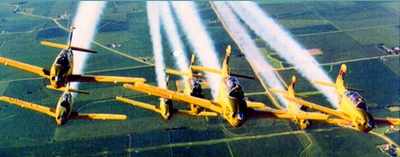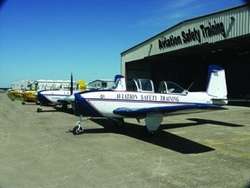Mon, Mar 15, 2004
EAA, AOPA, T-34 Association Trying To Prevent Entire Fleet From
Being Grounded
Sport and GA advocacy groups are banding together to stop the
FAA from grounding the entire T-34 fleet. And it seems to be
working.

The FAA has now approved an alternative methods of compliance
(AMOC) submitted by the T-34 Association regarding revised
airworthiness directive (AD) 2001-13-18 R1 that deals with T-34
wing spar failures. The revised AD recently invalidated previous
AMOCs approved for the original AD because FAA feels they do not
address all four critical areas prone to fatigue cracks in the
aircraft’s wing spar assemblies. However, the T-34
Association submitted new AMOCs that incorporate inspection of the
rear spars.
Without approved AMOCs, a large number of the aircraft will
effectively be grounded when the revised AD goes into effect
Monday. Affected aircraft include Raytheon Aircraft Corp. Beech
Models 45 (YT-34), A45 (T-34A, B-45), and D45 (T-34B).
 "We don't have hard numbers yet, but
it appears that a very high percentage of T-34s will be grounded,"
said AOPA Director of Regulatory and Certification Affairs Luis
Gutierrez. "The few shops that are authorized to do the necessary
work are already backlogged. These backlogs could lead to
significant delays in scheduling and extended down time for
aircraft owners."
"We don't have hard numbers yet, but
it appears that a very high percentage of T-34s will be grounded,"
said AOPA Director of Regulatory and Certification Affairs Luis
Gutierrez. "The few shops that are authorized to do the necessary
work are already backlogged. These backlogs could lead to
significant delays in scheduling and extended down time for
aircraft owners."
In 1999 a T-34 engaged in mock aerial combat crashed. The
resulting examination revealed fatigue cracks at multiple locations
in the wings of the accident aircraft. As an interim fix, the FAA
issued an AD instating airspeed and G-load limitations while
Raytheon developed a "mandatory" service bulletin to inspect the
critical fatigue locations. In 2001 FAA finalized the AD mandating
wing-spar inspections and approved four AMOCs to address fatigue
concerns. Then in November 2003, a second T-34 crashed after
experiencing a separation of the right wing. Two people died in that Texas crash.
In both cases, the wing separated at the same point on the
aircraft. The only difference was that the second aircraft had an
additional separation point at the lower wing attach fitting not
inspected in any of the AMOCs issued for the original AD.
More News
DETRESFA (Distress Phrase) The code word used to designate an emergency phase wherein there is reasonable certainty that an aircraft and its occupants are threatened by grave and i>[...]
"General aviation is at the forefront of developing and introducing innovative technologies that will transform the entire aviation industry..." Source: Kyle Martin, Vice President>[...]
Direct Straight line flight between two navigational aids, fixes, points, or any combination thereof. When used by pilots in describing off-airway routes, points defining direct ro>[...]
Aero Linx: Women in Corporate Aviation Women in Corporate Aviation support individuals seeking career advancement and professional development in the business aviation industry. Me>[...]
“We would like to thank the many volunteers that help throughout the year to pull off the event, as well as the several reviewers, judges, and SURVICE staff that provide team>[...]
 ANN's Daily Aero-Term (04.26.24): DETRESFA (Distress Phrase)
ANN's Daily Aero-Term (04.26.24): DETRESFA (Distress Phrase) Aero-News: Quote of the Day (04.26.24)
Aero-News: Quote of the Day (04.26.24) ANN's Daily Aero-Term (04.27.24): Direct
ANN's Daily Aero-Term (04.27.24): Direct ANN's Daily Aero-Linx (04.27.24)
ANN's Daily Aero-Linx (04.27.24) Aero-News: Quote of the Day (04.27.24)
Aero-News: Quote of the Day (04.27.24)




